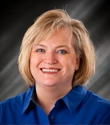Nov 24, 2021
Technical Assistance Helps Community #SilencetheShameTN
 When Henry County
Medical Center (HCMC) and the community of Paris,
Tennessee, wanted to combat behavioral and mental health
challenges in their community, they used the technical
assistance and resources provided by the Delta Region
Community Health Systems Development (DRCHSD) program to
address their needs. Launched in the middle of a global
pandemic, the #SilencetheShameTN initiative found
innovative ways to reach the community despite the need
for social distancing and the inability to bring people
together. They found some of the best tools to educate
people about behavioral and mental health issues were to
“keep it real” and “make it
personal”; when you do that, you can make a
difference at any distance.
When Henry County
Medical Center (HCMC) and the community of Paris,
Tennessee, wanted to combat behavioral and mental health
challenges in their community, they used the technical
assistance and resources provided by the Delta Region
Community Health Systems Development (DRCHSD) program to
address their needs. Launched in the middle of a global
pandemic, the #SilencetheShameTN initiative found
innovative ways to reach the community despite the need
for social distancing and the inability to bring people
together. They found some of the best tools to educate
people about behavioral and mental health issues were to
“keep it real” and “make it
personal”; when you do that, you can make a
difference at any distance.
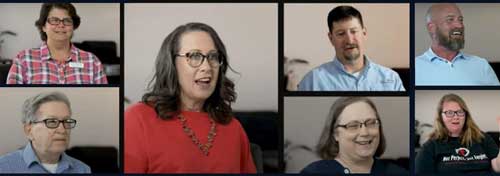
The Delta Region Community Health Systems Development (DRCHSD) Program
Through a cooperative agreement with the Health Resources and Services Administration's Federal Office of Rural Health Policy (FORHP), and with the support of the Delta Regional Authority (DRA), the National Rural Health Resource Center (The Center) in Duluth, Minnesota, provides technical assistance and implementation for healthcare organizations located in DRA-designated counties and parishes. The Center administers the DRCHSD program and manages the provision of services to the selected 32 healthcare organizations and 30 communities over a three-year program period to make in-depth health system enhancements to position the organizations and communities for improved population health.
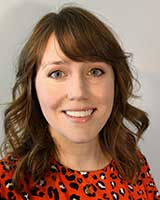
Based on a cohort model, ten healthcare organizations in the Delta Region are selected each year through an application process to participate. Beginning in 2017, the program uses a three-year model that provides intensive, comprehensive technical assistance in eight goal areas. These goal areas focus on implementing best practices, building partnerships, and collaborating for sustainability. The technical assistance provided is tailored to address the healthcare organization and the community's health needs. According to Suzanne Snyder, Public Health Analyst at FORHP and DRCHSD Project Officer, the assistance provided by the program is strengthening the healthcare delivery system in the Mississippi Delta Region. Eleven organizations have graduated the program since inception.
Eligibility for the program includes small rural hospitals, Prospective Payment System (PPS) acute care facilities up to approximately 100 beds, Critical Access Hospitals, Rural Health Clinics, and other healthcare organizations located in DRA-designated counties and parishes.
One of the innovative resources employed by the program that aids in coalition building and program implementation is funding for a community champion position at the local level to assist the organization with community care coordination development and sustainability. Snyder describes the part-time community champion as an individual “whose sole focus is community care coordination: training, learning to engage community partners, have a pulse on the community, and how to have conversations.”
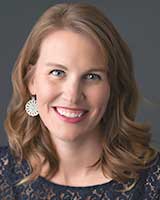
“The champion is the one that spearheads and oversees the activities alongside the community partners. They work most directly with the community. The program helps champions stand on their own and, by the time they are done, the community recognizes the champion as a leader and liaison to highlight the healthcare organization,” added Kaarin Lund, a Community Program Specialist with The Center who works with communities to implement the community care coordination aspect of the DRCHSD program.
#SilencetheShameTN
HCMC has always valued collaboration. Hospital CEO Lisa Casteel and community champion Gina Matlock had assembled a group of diverse community partners, performed a community needs assessment, and identified the gaps in their community. Matlock described members of the group recounting how they repeatedly heard about the same behavioral and mental health issues as well as addiction to illegal substances: “It was sad to see people in the shadows not getting the care they need.” The coalition wanted to focus on behavioral health but didn't know where to start. To help them realize their vision, Matlock took the lead.
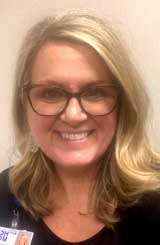
Having lived in the community for over 20 years, Matlock had numerous community contacts. She was known as friendly and vocal and was just as comfortable speaking to groups or one-on-one. But she spoke passionately about the secret to her success: “Your heart has to be in it. It's one of the things that has powered this initiative.”
Lund agreed, “One of the differences of this collaboration of community partners is that they were motivated from the beginning to make an impact together. Their strong leadership creates an environment that community organizations want to participate in to address the needs of residents, and other rural healthcare organizations will want to replicate.”
With the assistance of the DRCHSD program, a virtual priority action planning workshop was held with HCMC leadership, the community champion, and community partners to confirm collaboration and plan future activities. The meeting highlighted assets of the community, focusing on opportunities instead of just barriers. Over 20 community partners pledged their support and resources at that meeting. The coalition reviewed data and held focus groups. This led to a decision to prioritize 1) Increasing Behavioral Health Access, 2) Providing Behavioral Health Education, and 3) Addressing Poverty (by making residents aware of local resources and helping them access them). Lund highlights, “Their commitment to listen to residents, build capacity for outpatient behavioral health services, provide education in an innovative way for all, collaborate with partners, and address health equity by ensuring access to care will create policy, system, and environmental changes that can sustain their efforts for the future.”
The group kicked off the #SilencetheShameTN initiative in May 2021 in recognition of Mental Health Month and set out to raise awareness through a multi-generational initiative to meet residents where they were, said Matlock. This included standing outside grocery stores and talking to people; dropping off materials at assisted living facilities, schools, and parks; and speaking to civic groups. Eager to share resources and resonate with audiences young and old, the community coalition created and distributed a resource guide, encouraged social media posts, and handed out other printed materials such as palm cards with information about resources for help. All the materials created were placed on a behavioral health landing page on the hospital website, including the resource guide, all the videos, and other community resources.
Matlock grew excited as she spoke about two of the most powerful pieces of the initiative, TikTok videos created and posted by community teens and a video series with real community members sharing their struggles and experiences with mental and behavioral health issues.
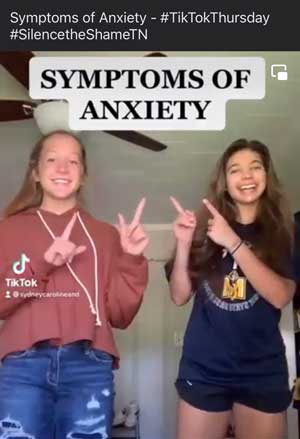
The community coalition encouraged local youth to search the popular social media platform TikTok for videos relating to behavioral health to generate ideas for their own videos aimed at creating awareness. The teens brought their favorite videos and ideas to the group. After Matlock approved the video concepts, the teens created new TikToks, posted, and shared them.
People in the community started sharing the videos as well and that gave some parents the courage to speak to their own teens about sensitive issues. One parent shared with Matlock that they were afraid to approach their teen about some of the things they were seeing at home but did so after the initiative. One of the best responses Matlock spoke to was when a mother came in and explained that her daughter was seeing all of the TikToks and wanted to be involved. She described how her daughter had been diagnosed with a mental illness since the age of six and no one in the community had any idea. She ended up creating a video for suicide awareness. She pointed out, “People aren't out walking around with a label.”
Additionally, the community group wanted to create a video series using real community members talking about their experiences with behavioral and mental health, but that wasn't easy. “It was a challenge at first,” said Matlock. “We made a Facebook post asking for folks to speak to their personal experience and asking them to contact the group. No responses. No likes. Literally crickets. That said a lot in and of itself. People were scared to come forward.”
So, members of the community group started reaching out to people they knew personally had overcome struggles or were still experiencing behavioral or mental health issues and invited them to tell their stories. Some did, some didn't, and the group was extremely happy that they ended up with seven videos telling a variety of stories.
The videos knocked down walls. You can tell people, share information on social media, give statistics, but nothing reaches people like real people. We were about keeping it real.
“The videos knocked down walls,” explained Matlock. “You can tell people, share information on social media, give statistics, but nothing reaches people like real people. We were about keeping it real. Stigma was a huge obstacle. Our motto was 'Keeping it Real…Making it Personal.'”
The videos were powerful and popular. One of the video participants, Missy Hamilton, recounted the personal impact she witnessed because of the series: “A lady approached me to thank me for my part in the video series. She said it was inspiring. A couple weeks later I told her to check out the videos released in their entirety. She simply said, 'Please pray for me, I've made an appointment.'”
Even the man who shot the video series was moved to provide feedback on what he saw. Sam Huston of Crove Media wrote, “I had the honor of working on this project with my team and this is a project that will have forever changed my life! This project was eye-opening in many ways and it allowed me to see how truly blessed I am. It also allowed me to realize the severity of the challenges that mental health faces. After conducting over 20 interviews, the message never really changed. Each person was speaking from a different perspective when it comes to behavioral health, yet the message was consistent. People who face mental health challenges carry the burden of judgment, shame, and fear on top of the issues they have, which only worsens the problem. This experience has humbled me in so many ways and I for one have benefited from the stories that have been told and now possess the information needed that could help someone else by knowing what resources are available in our community! Throughout the project I have had so many people reach out on social media and in person to share their gratitude for those who were courageous enough to share their personal stories of struggle. This vulnerability that they showed will certainly help others who may be facing similar challenges.”
Together, the TikToks and videos have been viewed almost 21,000 times.
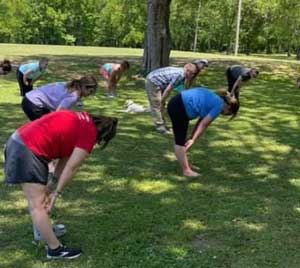
Implementing a community project in the middle of a global pandemic proved to be one of the unprecedented challenges the group would face, but Matlock described how they rose to the occasion: “There were times we could accelerate or pump the brakes depending on the cases in the community and hospital. The group tried to keep reaching out by dropping things off at community organizations, using social media and the website. We were out and about when we could be and we used masks and social distanced by being outdoors.” Yoga in the Park was an event that rose out of the desire to do a community awareness event that was safe and allowed for social distancing.
Matlock was appreciative of the community partners' help to make the initiative a success. She highlighted a local physician who was a huge support, spoke on an intro to the video series, and advocated for more outpatient care. She also acknowledged the community members who participated in videos, shared media posts, and outlined services to assist other community members in gaining access to resources. She also shared how the group used the existing resources of employers, such as Employee Assistance Programs, and the hospital, which covered the cost of the resource guide. The faith community was also an active partner.
She encouraged communities looking to create partnerships and coalitions like the one they created to think outside the box when asking for community partners: “Don't overlook the library for resources, pastors, daycare centers, employers. Go through the community with a fine-tooth comb.”
Another goal of the program achieved by the initiative was to increase access to behavioral health services in the community. Matlock described how additional outpatient care was being implemented in the community through one of the local Rural Health Clinics. She stated that one of the gaps identified was that the community did not have outpatient care, so they looked at different options and will be expanding services through the use of telehealth.
This project, because they are showing community members showing their emotions — people connected, and it gave them hope. We are proud of them.
Lund lauded the efforts by HCMC to personalize the #SilencetheShameTN initiative and how those efforts have made community members pick up the phone to talk to a counselor: “This project, because they are showing community members showing their emotions — people connected, and it gave them hope. We are proud of them.”
DRCHSD's Community Care Coordination
Along with developing a baseline through assessment and analysis, one of the focuses of the first year of the DRCHSD program for participating organizations is community care coordination and building a foundation to identify and connect with community partners. This supports the creation of collaboration that can address the communities' healthcare gaps together. All of the cohort communities start at the same place — planning and developing — but what they work on; the breadth, depth, and diversity of the partners they bring to the table; and how fast they move is all up to them. In addition, Lund says the program is unique in that it can assist organizations with implementing recommendations that come out of the assessments. The model moves the community through planning and development, to implementation, and, ultimately, sustainability. Lund explained that the program asks a lot of the community and their healthcare organizations: “We are looking for them to be sustainable for many years. The program supports the facility and the community to build the relationships that will achieve that.”
Learn more about the Delta Region Community Health Systems Development Program and Henry County Medical Center's behavioral health initiatives by visiting their websites.

